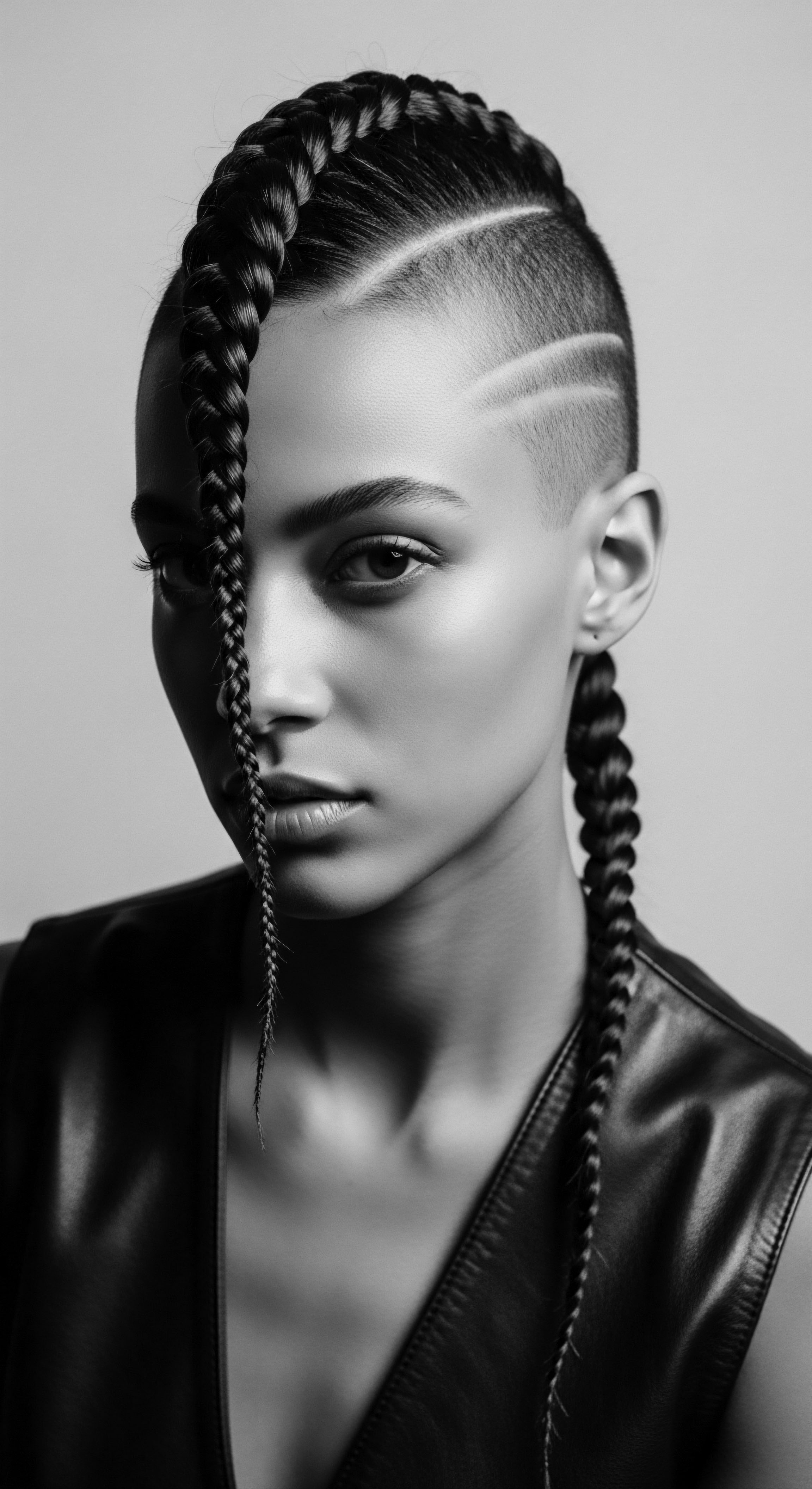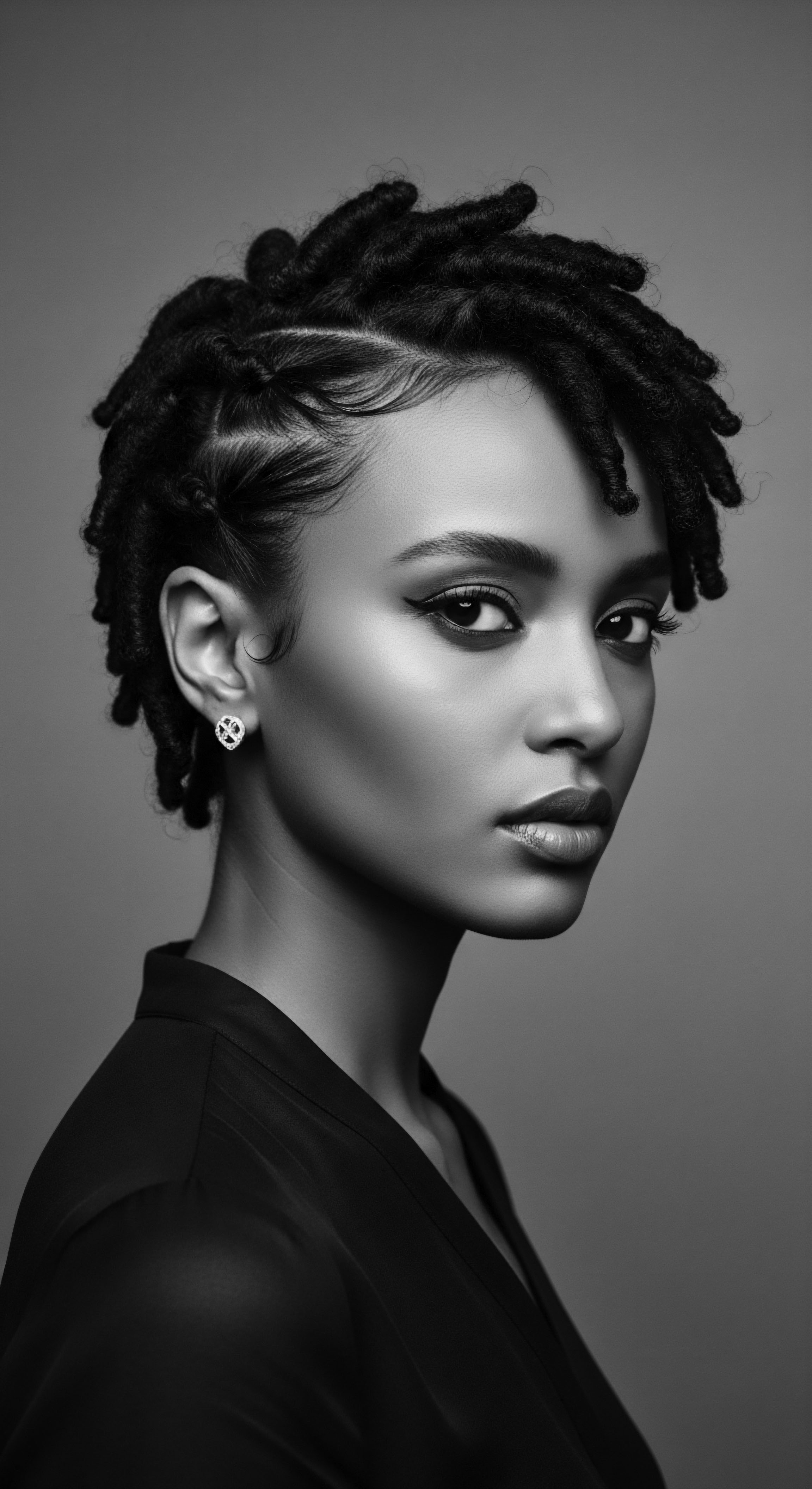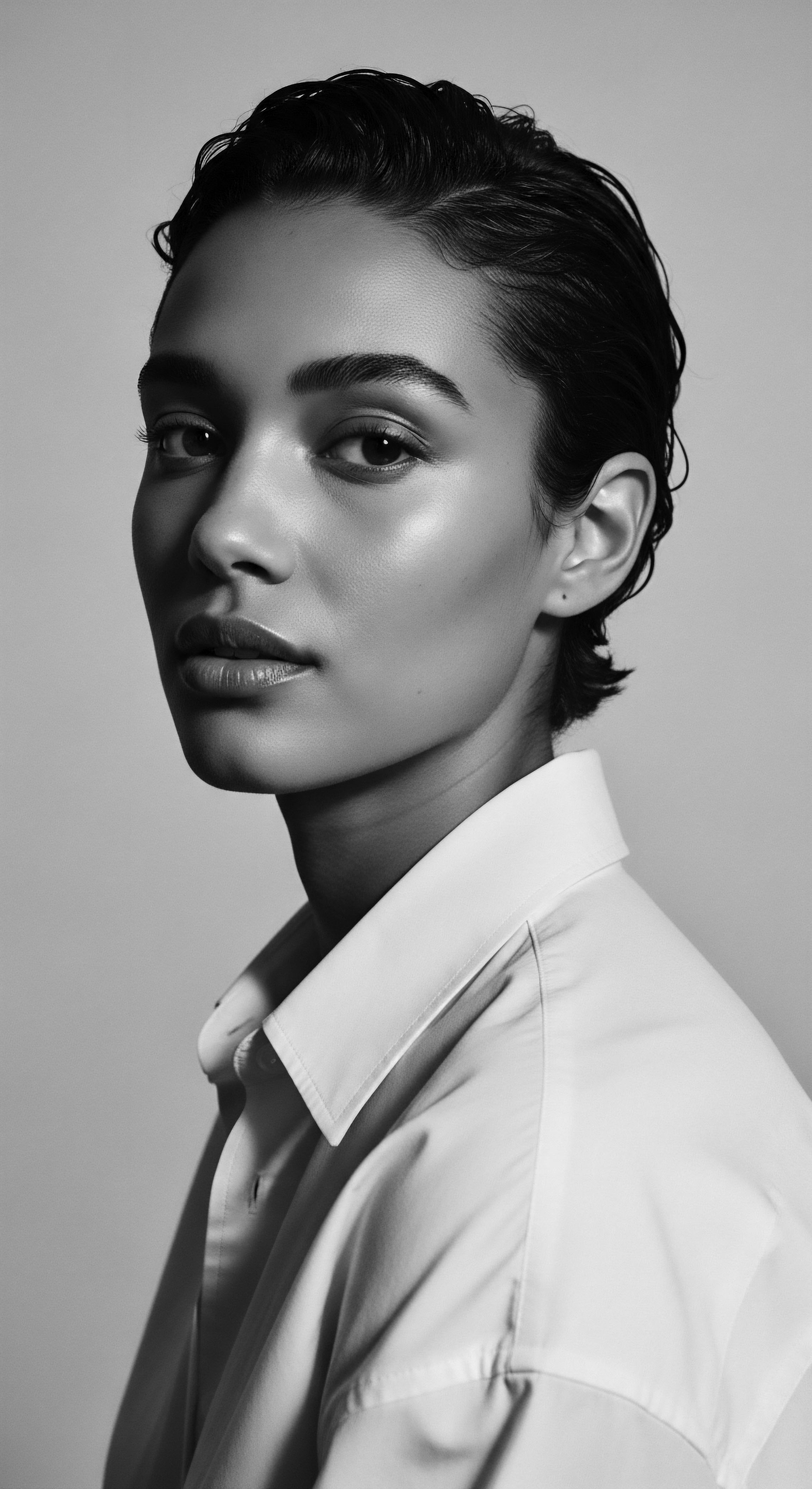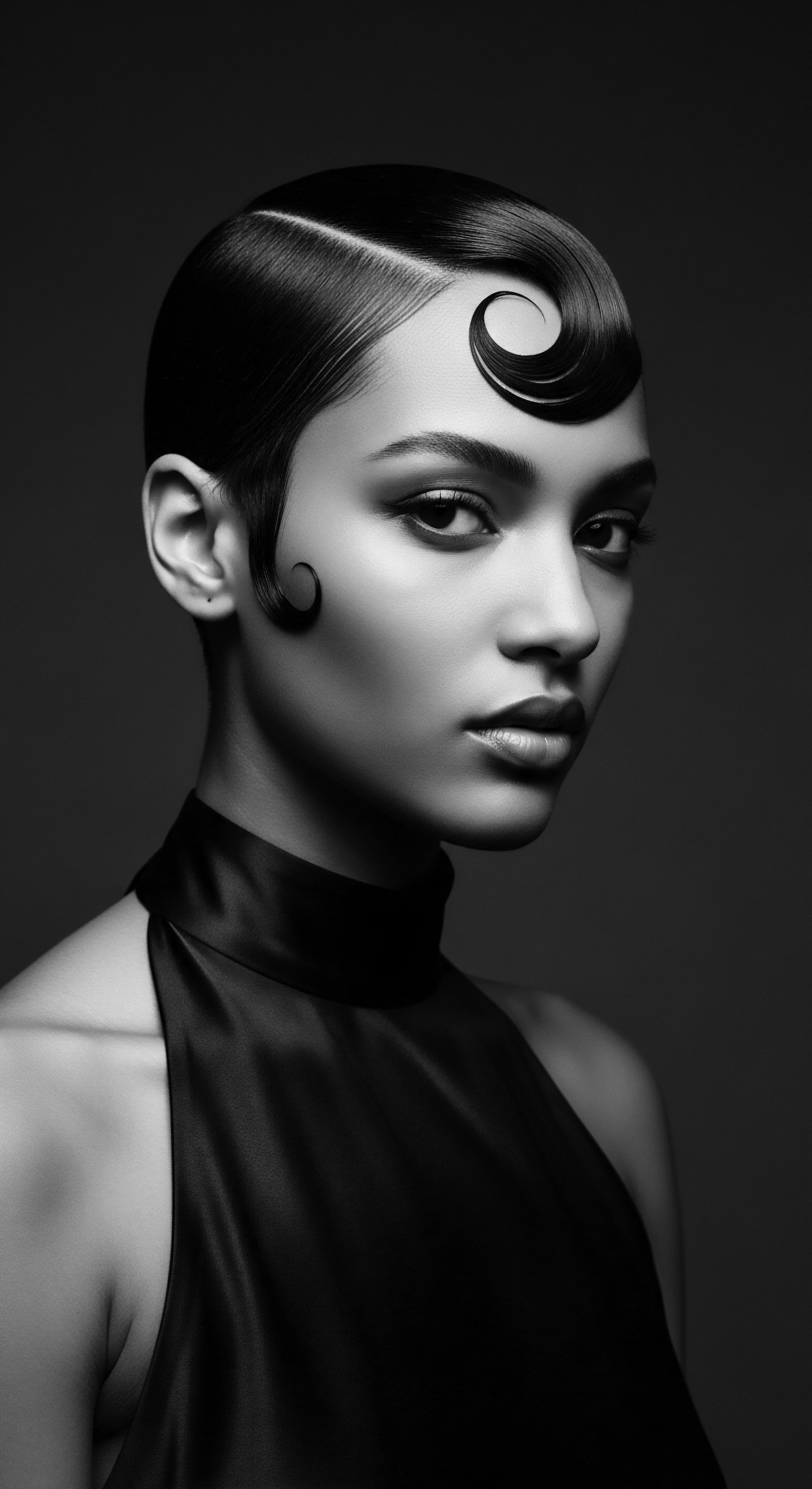
Fundamentals
The Hair Threading, at its core, represents a venerable practice, a gentle yet effective method of shaping and removing hair from the root using a fine cotton or polyester thread. This technique involves twisting the thread into a loop, which then deftly ensnares individual hairs, lifting them from their follicles with a precise, rolling motion. Its straightforward nature, requiring only a skilled hand and a length of thread, belies a profound historical and cultural significance, particularly within communities that have long celebrated the inherent qualities of textured hair. This ancient practice, often seen as a simpler alternative to modern hair removal methods, holds a special place in the lineage of personal care, connecting contemporary grooming rituals to ancestral wisdom.
Understanding the Hair Threading begins with appreciating its elemental simplicity. A practitioner holds a length of thread, often cotton, between their hands, sometimes even utilizing their mouth to create tension. The thread is then twisted, forming a small, dynamic loop. This loop becomes the instrument of precision, carefully guided over the skin.
As the practitioner moves their hands, the twisted section of the thread opens and closes, grasping hairs and lifting them from their follicular anchors. This mechanical action allows for the removal of multiple hairs at once, providing a clean and defined finish. The technique is celebrated for its ability to sculpt precise lines, making it a favored choice for eyebrow shaping and facial hair removal, especially for those with sensitive skin.
Hair Threading is a precise, ancient hair removal technique using twisted thread, connecting modern grooming to ancestral care practices.
Beyond its mechanical delineation, the meaning of Hair Threading extends into a realm of cultural resonance. It is a practice passed down through generations, often within families or communities, transforming a simple act of grooming into a shared experience. This communal aspect reinforces its position not merely as a hair removal method, but as a living tradition.
The absence of harsh chemicals or heated substances further positions it as a gentle approach, aligning with a philosophy of care that respects the body’s natural state. Its efficacy on various hair textures, including the delicate nature of vellus hair, makes it a versatile tool in the broader landscape of personal adornment.

Ancestral Echoes of Care
The historical roots of Hair Threading stretch back millennia, echoing across continents from ancient Persia and India to parts of Africa. This deep history speaks to a shared human desire for self-presentation and a profound understanding of natural materials. The simplicity of the thread as a tool underscores a time when reliance on natural resources and skilled hands was paramount. This ancient lineage gives the practice a timeless quality, suggesting a continuous thread of human ingenuity in the pursuit of beauty and well-being.
- Origins in Asia ❉ Evidence suggests the practice originated in India and Central Asia, potentially over 6,000 years ago, becoming a beauty ritual for royal and elite women.
- Persian Rites ❉ In ancient Persia, eyebrow threading marked a significant rite of passage, symbolizing a young woman’s readiness for marriage.
- African Stylings ❉ In various Sub-Saharan African societies, particularly among the Yoruba people of Nigeria, hair threading, known as Irun Kiko, has been a cherished traditional hairstyle for centuries, serving as a cultural marker and protective style.

The Elemental Biology of Hair Removal
From a biological perspective, Hair Threading functions by ensnaring the hair shaft and pulling it directly from the follicle. This action removes the entire hair, including the bulb, which results in a smoother finish and a longer regrowth period compared to methods that merely cut hair at the skin’s surface. The precision of the technique allows for targeted hair removal, shaping areas with fine control, which is particularly beneficial for delicate facial areas. This precision minimizes irritation to the surrounding skin, making it a preferred choice for individuals with sensitive complexions.
The physical interaction between the twisted thread and the hair follicle is a testament to the ingenious application of basic physics. The friction and tension created by the rapidly moving thread act as a miniature lasso, gripping hairs at their base. This mechanical extraction avoids the chemical interactions associated with depilatories or the heat involved in some waxing procedures, reducing the likelihood of allergic reactions or burns. The repetitive, rhythmic motion of the threading process itself can be a meditative experience for both practitioner and recipient, further connecting it to a holistic sense of care.

Intermediate
Moving beyond its fundamental delineation, the Hair Threading emerges as a sophisticated practice, an explanation of intricate hair removal that transcends mere technique to embody deep cultural meanings and practical advantages, particularly for textured hair. Its significance, often understated in contemporary beauty discourse, truly shines when viewed through the lens of heritage and the unique needs of diverse hair types. This method, far from being a simple act, represents a continuity of knowledge, a testament to the ingenuity of ancestral care rituals.
The precise operation of Hair Threading involves a nuanced understanding of hair growth patterns and follicular orientation. A practitioner manipulates a doubled and twisted cotton or polyester thread, rolling it over the skin. The hairs become trapped within the twists of the thread, and with a swift, controlled movement, they are lifted from the root.
This methodical extraction allows for remarkable accuracy, enabling the creation of crisp lines and defined shapes, a characteristic that sets it apart from less controlled methods. This careful approach minimizes trauma to the surrounding skin, a vital consideration for individuals prone to irritation or ingrown hairs.
Hair Threading’s precise hair removal, deeply rooted in cultural traditions, offers significant benefits for textured hair by minimizing irritation and honoring ancestral care.

The Tender Thread ❉ A Legacy of Care for Textured Hair
For individuals with textured hair, particularly those within Black and mixed-race communities, the Hair Threading holds a particular significance. The coiled nature of textured hair can make it more susceptible to ingrown hairs when subjected to certain removal methods that cut hair bluntly or pull it against its natural growth pattern. Threading, by pulling the hair directly from the follicle with precision, can help mitigate this concern. This gentle yet effective approach aligns with a philosophy of hair care that prioritizes scalp health and minimizes potential damage, echoing long-standing ancestral wisdom in nurturing hair.
Historically, within many African societies, hair was not merely an aesthetic element; it was a profound marker of identity, status, age, and spiritual connection. While much of the historical documentation around “threading” as hair removal specifically points to facial hair in Middle Eastern and South Asian contexts, the broader concept of using thread for hair management and styling has a deeply embedded history in African hair traditions. For instance, the Irun Kiko practice among the Yoruba people of Nigeria involves wrapping sections of hair with thread from root to tip.
This technique, though primarily a styling and protective method, shares the core principle of using thread to manipulate hair, promoting length retention and safeguarding strands from environmental stressors. This demonstrates a parallel ancestral understanding of thread’s utility in hair care, moving beyond mere removal to encompass broader principles of hair health and adornment.
| Traditional Application Facial Hair Removal (e.g. eyebrows, upper lip) |
| Purpose within Heritage Context Marking rites of passage (e.g. marriage readiness in Persia), social refinement, ritualistic cleanliness. |
| Contemporary Relevance for Textured Hair Precision shaping, gentle removal for sensitive skin, reduced irritation compared to waxing, particularly beneficial for preventing ingrown hairs on coarser facial hair. |
| Traditional Application Hair Styling/Stretching (e.g. Irun Kiko in West Africa) |
| Purpose within Heritage Context Protective styling, elongating natural coils without heat, cultural expression, community bonding, status signaling. |
| Contemporary Relevance for Textured Hair Heat-free stretching for length retention, protective styling, minimizing breakage, promoting moisture retention, and a direct connection to ancestral grooming techniques for natural hair. |
| Traditional Application The application of thread in hair care, whether for removal or styling, consistently reflects a deep respect for the hair's integrity and its cultural significance across various ancestral traditions. |

The Science of Gentle Extraction
The effectiveness of Hair Threading stems from its unique mechanical action. Unlike waxing, which adheres to the skin’s surface and can cause significant pulling or irritation, threading primarily targets the hair itself. This selective action minimizes stress on the delicate epidermal layers, making it a suitable choice for those with reactive or sensitive skin. The precise removal of hair from the follicle also means a slower regrowth cycle, providing longer-lasting smoothness without the sharp stubble associated with shaving.
From a dermatological standpoint, the absence of chemicals or heat in the threading process presents a distinct advantage, especially for individuals with skin conditions or those who prefer natural beauty regimens. This aligns with a holistic approach to wellness, where the body is treated with reverence and harsh interventions are avoided. The practitioner’s skill lies in their ability to manipulate the thread with fluidity, ensuring a smooth, swift extraction that respects the hair’s natural growth direction. This methodical removal helps to prevent common post-hair removal issues such as razor bumps or folliculitis, concerns that can be particularly pronounced with tightly coiled hair textures.

Academic
The Hair Threading, viewed through an academic lens, presents a complex phenomenon that transcends its functional designation as a hair removal technique. It stands as a profound statement, an elucidation of human ingenuity, cultural resilience, and the deeply embedded socio-cultural significance of hair across diverse populations, particularly within the vast and varied landscape of textured hair heritage. This academic interpretation delves into its historical anthropology, its biological mechanics, and its enduring psychosocial ramifications, offering a comprehensive understanding of its meaning and its profound impact on identity and communal practices.
At its most fundamental, the Hair Threading is a mechanical epilation method where a twisted cotton or polyester thread is maneuvered to entangle and extract hair from the follicle. This process, known in various cultures by terms such as Bande Abru (Southeast Asia), Khite (Middle East), Fatlah (Egypt), or Wanmian (China), demonstrates a universal human inclination towards grooming and aesthetic modification of the corporeal form. The precision inherent in the technique allows for the removal of fine vellus hairs as well as coarser terminal hairs, providing a clean line and a smooth dermal surface without chemical intervention or significant epidermal abrasion. The significance of this lies not only in its physical outcome but also in its historical longevity and its adaptation across disparate cultural geographies.
The Hair Threading is a testament to cultural resilience, demonstrating an enduring practice of precise hair extraction that holds deep socio-cultural meaning across diverse textured hair communities.

Echoes from the Source ❉ Hair Threading as a Cultural Artifact
The historical trajectory of Hair Threading is not linear; it is a rich tapestry woven with threads of migration, adaptation, and cultural exchange. While often associated with the Middle East and South Asia, with origins tracing back over 6,000 years in regions like India and Iran, its presence and parallel development in various African communities offer a compelling case for its independent or deeply integrated evolution within textured hair traditions. In ancient Persia, the practice held a ritualistic designation, marking a young woman’s passage into adulthood and readiness for marriage, often involving the shaping of eyebrows. This ceremonial aspect elevates the technique beyond mere cosmetic utility, positioning it as a performative act deeply embedded in social structure and identity formation.
For communities with textured hair, particularly those across the African diaspora, the concept of “threading” manifests with a broader, yet equally profound, cultural designation. African hair threading, often called Irun Kiko among the Yoruba people of Nigeria, represents a centuries-old styling technique that utilizes thread to wrap sections of hair, promoting length retention, protecting strands, and creating sculptural, expressive forms. This application, distinct from facial hair removal, nonetheless shares the fundamental principle of using thread to manipulate and care for hair. It is a powerful example of how ancestral knowledge systems adapted natural materials to meet specific hair needs, fostering both aesthetic expression and hair health.
Consider the profound sociological import of Irun Kiko. Before the advent of modern chemical straighteners or widespread heat styling, African hair threading offered a heat-free method to stretch and elongate tightly coiled hair, facilitating manageability and styling versatility while minimizing breakage. This practice served as a crucial protective style, shielding delicate strands from environmental damage and contributing to hair health and growth. Moreover, it functioned as a visual language, with specific styles conveying tribal affiliation, marital status, or social standing.
The communal act of threading, often performed by women for women, fostered intergenerational bonding and served as a vehicle for transmitting cultural heritage and embodied knowledge. This deeply rooted cultural practice highlights how hair care is not an isolated act but a communal ritual that strengthens social ties and preserves identity across generations.
A specific historical example powerfully illuminates this connection to textured hair heritage and ancestral practices. During the era of enslavement in the Americas, traditional African hair care practices faced systematic suppression, yet they persisted as quiet acts of resistance and cultural preservation. Accounts from formerly enslaved individuals, such as “Aunt Tildy” Collins in the Born in Slavery ❉ Slave Narratives from the Federal Writers’ Project, describe how enslaved women would use a “jimcrow” (likely a wool carder for detangling) and then thread their hair with fabric or cotton. This technique was specifically employed to achieve defined curls when the threads were undone, providing a method to style and protect hair without access to conventional tools or products.
This adaptation of threading, rooted in ingenuity and necessity, demonstrates its enduring relevance for Black hair experiences, transforming a simple technique into a symbol of resilience and a link to a suppressed heritage. This narrative underscores how Hair Threading, in its various forms, became a means of maintaining cultural identity and personal dignity in the face of immense adversity.

The Unbound Helix ❉ Biological and Dermatological Considerations for Textured Hair
From a biological standpoint, the Hair Threading’s mode of action is particularly beneficial for textured hair. The tightly coiled structure of Black and mixed-race hair, while beautiful and resilient, can be prone to specific challenges, including dryness and a propensity for ingrown hairs (pseudofolliculitis barbae) when hair is cut or pulled improperly. Unlike shaving, which severs hair at an angle, or waxing, which can pull at the skin and potentially cause follicular trauma, threading precisely extracts the hair from the root.
This minimizes the blunt cutting of the hair shaft that can lead to ingrown hairs, as the hair is removed cleanly and completely. The gentle nature of the process, free from chemical irritants or excessive heat, reduces the risk of inflammation and hyperpigmentation, common concerns for melanin-rich skin.
The mechanical delineation of Hair Threading also presents a distinct advantage in terms of follicular health. By removing the entire hair from the follicle, it promotes a longer period of smoothness, which in turn reduces the frequency of hair removal, lessening repetitive stress on the skin and follicles. This sustained period of hair absence allows the skin to recover, minimizing the cumulative irritation often associated with daily or weekly hair removal regimens. For individuals managing conditions such as sensitive skin or acne-prone complexions, the non-abrasive and chemical-free nature of threading offers a preferred alternative, aligning with dermatological recommendations for gentle skin care.
The application of Hair Threading extends beyond cosmetic shaping to encompass broader implications for scalp and hair health. The stretching effect achieved by African hair threading techniques, for instance, can temporarily alter the hair’s coiled structure, allowing for easier detangling and product application, which is crucial for maintaining moisture and preventing breakage in textured hair. This physical manipulation, performed without the damaging effects of heat, preserves the hair’s natural moisture balance, a critical aspect of textured hair care. The ancestral understanding embedded in these practices, validated by contemporary hair science, highlights a holistic approach to hair care that prioritizes preservation and nourishment.
Moreover, the precise nature of threading makes it a suitable option for managing fine, delicate hairs, such as vellus hair, which can be challenging to remove with other methods without causing skin irritation. This meticulous approach ensures that only the desired hairs are targeted, allowing for the sculpting of highly defined shapes, particularly around the eyebrows and hairline. The absence of sticky residues, as is common with waxing, further simplifies the post-treatment care, contributing to a more comfortable experience and reducing the likelihood of clogged pores or breakouts.

The Unbound Helix ❉ Sociocultural Implications and Identity
The meaning of Hair Threading extends into the profound realm of identity and self-expression, particularly within diasporic communities. For many, maintaining traditional grooming practices, including threading, represents a conscious act of cultural affirmation and a tangible link to ancestral heritage. In a world often dominated by Eurocentric beauty standards, the choice to practice or seek out threading can be a statement of pride in one’s origins and a rejection of homogenizing beauty norms. This act of preservation becomes a living archive, a means of keeping ancestral customs alive and transmitting them to future generations.
The global resurgence of Hair Threading, especially in Western contexts, is not merely a trend but a reflection of growing appreciation for traditional, natural, and culturally significant beauty practices. Immigrant communities from South Asia, the Middle East, and Africa have been instrumental in establishing threading as a widely accessible service, transforming it from a niche practice into a recognized and sought-after beauty treatment. This cultural migration has facilitated a broader understanding of its benefits, particularly its gentleness and precision, leading to its adoption by a wider demographic. The act of receiving threading services from practitioners who share cultural roots can also foster a sense of community and belonging, creating spaces where heritage is celebrated and preserved.
The communal aspect of hair care, historically central to many African and South Asian societies, finds resonance in the contemporary threading experience. While modern salon settings may differ from traditional communal gatherings, the shared experience of beautification and the intergenerational transfer of skills remain significant. The practitioner, often a custodian of ancestral knowledge, performs more than a service; they participate in a ritual that connects individuals to a broader cultural narrative. This connection underscores the profound significance of Hair Threading as a vehicle for cultural sustainability and a means of maintaining collective identity in a rapidly globalizing world.

Reflection on the Heritage of Hair Threading
The journey through the intricate world of Hair Threading reveals more than a simple technique for hair removal; it unveils a profound meditation on the enduring legacy of textured hair, its deep heritage, and the tender care it has received across generations. From the elemental biology of a single strand to the complex tapestries of communal identity, threading stands as a testament to human ingenuity and the timeless pursuit of holistic well-being. It is a whisper from ancient hearths, a gentle touch from ancestral hands, reminding us that true beauty is often found in the simplest, most time-honored practices.
As we reflect upon its journey from the intimate spaces of family homes in ancient Persia and bustling markets of West Africa to the modern salons of today, the meaning of Hair Threading remains rooted in its ability to connect us to a past rich with wisdom. It speaks of a time when beauty rituals were deeply intertwined with social rites, spiritual preparation, and the communal strengthening of bonds. For those with textured hair, this practice carries an even deeper resonance, embodying resilience, self-preservation, and a continuous affirmation of identity in the face of historical challenges. It offers a tangible link to the ingenious methods our ancestors devised to protect, style, and honor their crowns, long before the advent of industrial beauty products.
The Soul of a Strand ethos finds its vibrant expression within the gentle loops of the threading technique. Each precise pull, each sculpted line, echoes the meticulous care and profound respect that has historically been accorded to hair within Black and mixed-race traditions. It reminds us that our hair is not merely a collection of fibers; it is a living archive, holding stories of resilience, creativity, and unbroken lineage.
The ongoing practice of Hair Threading, whether for precise facial grooming or for the protective styling of coils, continues to write new chapters in this living library, ensuring that the wisdom of the past continues to shape and inspire the futures of our strands. It is a quiet yet powerful affirmation that ancestral knowledge remains a guiding light in our contemporary understanding of hair care and self-expression.

References
- CIAFE HQ. (2022). Understanding African Hair Threading – Explainer. CIAFE .
- Craig, L. & Gray, P. B. (2019). What’s Your Attitude About Body Hair Removal? UNLV .
- Locks Lash. (2021). Waxing & Threading – Where did it come from? Locks Lash .
- Olupona, B. M. (2019). Tradition meets the present ❉ Busayo Michelle Olupona talks African Hair Threading. Connecting Afro Futures .
- Opare-Darko, K. N. & Dennis, K. N. (2023). Unveiling the Art of Indigenous Threaded Hairstyles in Some Selected Areas in Ghana. African Journal of Applied Research .
- Sherry Beauty. (n.d.). History of Facial Threading and Eyebrow Threading. Sherry Beauty .
- The Afro Hair & Skin Co. (2023). Embracing Tradition ❉ The Lost Art of African Hair Threading. The Afro Hair & Skin Co.
- The Brow Fixx. (2023). Eyebrow Threading Masters ❉ Ancient Techniques & Beauty. The Brow Fixx .
- The Nantwich Clinic. (2023). A Journey Through Time ❉ The Fascinating History of Hair Removal. The Nantwich Clinic .
- Times of India. (2024). Remove unwanted hair at home by using these natural methods. Times of India .
- UNLV. (2019). What’s Your Attitude About Body Hair Removal? UNLV .
- Wikipedia. (n.d.). African hair threading. Wikipedia .
- Wikipedia. (n.d.). Threading (epilation). Wikipedia .
- YorkSpace. (2021). Braided Archives ❉ Black hair as a site of diasporic transindividuation. YorkSpace .
- Ziba Beauty. (n.d.). History of Eyebrow Threading. Ziba Beauty .
